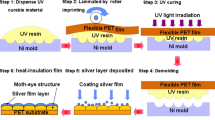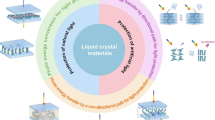Abstract
Counteracting surface fogging to maintain surface transparency is important for a variety of applications including eyewear, windows and displays. Energy-neutral, passive approaches predominantly rely on engineering the surface wettability, but suffer from non-uniformity, contaminant deposition and lack of robustness, all of which substantially degrade durability and performance. Here, guided by nucleation thermodynamics, we design a transparent, sunlight-activated, photothermal coating to inhibit fogging. The metamaterial coating contains a nanoscopically thin percolating gold layer and is most absorptive in the near-infrared range, where half of the sunlight energy resides, thus maintaining visible transparency. The photoinduced heating effect enables sustained and superior fog prevention (4-fold improvement) and removal (3-fold improvement) compared with uncoated samples, and overall impressive performance, indoors and outdoors, even under cloudy conditions. The extreme thinness (~10 nm) of the coating—which can be produced by standard, readily scalable fabrication processes—enables integration beneath other coatings, rendering it durable even on highly compliant substrates.
This is a preview of subscription content, access via your institution
Access options
Access Nature and 54 other Nature Portfolio journals
Get Nature+, our best-value online-access subscription
$29.99 / 30 days
cancel any time
Subscribe to this journal
Receive 12 print issues and online access
$259.00 per year
only $21.58 per issue
Buy this article
- Purchase on Springer Link
- Instant access to full article PDF
Prices may be subject to local taxes which are calculated during checkout





Similar content being viewed by others
Data availability
All data needed to evaluate the conclusions in the paper are present in the paper and/or the Supplementary Information. Figure source data can be found under https://www.research-collection.ethz.ch/handle/20.500.11850/574061 (Iwan Haechler, extended data for ‘Transparent sunlight-activated antifogging metamaterials’, Eidgenössische Technische Hochschule Zurich Research Collection, https://doi.org/10.3929/ethz-b-000574061, 2022).
References
Yoon, J. et al. Wet-style superhydrophobic antifogging coatings for optical sensors. Adv. Mater. 32, e2002710 (2020).
Howarter, J. A. & Youngblood, J. P. Self-cleaning and next generation anti-fog surfaces and coatings. Macromol. Rapid. Comm. 29, 455–466 (2008).
Durán, I. R. & Laroche, G. Current trends, challenges, and perspectives of anti-fogging technology: surface and material design, fabrication strategies, and beyond. Prog. Mater. Sci. 99, 106–186 (2019).
Leach, R. N., Stevens, F., Langford, S. C. & Dickinson, J. T. Dropwise condensation: experiments and simulations of nucleation and growth of water drops in a cooling system. Langmuir 22, 8864–8872 (2006).
Lin, S. et al. Stretchable anti‐fogging tapes for diverse transparent materials. Adv. Funct. Mater. 31, 2103551 (2021).
Cebeci, F. C., Wu, Z., Zhai, L., Cohen, R. E. & Rubner, M. F. Nanoporosity-driven superhydrophilicity: a means to create multifunctional antifogging coatings. Langmuir 22, 2856–2862 (2006).
Tzianou, M., Thomopoulos, G., Vourdas, N., Ellinas, K. & Gogolides, E. Tailoring wetting properties at extremes states to obtain antifogging functionality. Adv. Funct. Mater. 31, 2006687 (2021).
Nuraje, N., Asmatulu, R., Cohen, R. E. & Rubner, M. F. Durable antifog films from layer-by-layer molecularly blended hydrophilic polysaccharides. Langmuir 27, 782–791 (2011).
Mouterde, T. et al. Antifogging abilities of model nanotextures. Nat. Mater. 16, 658–663 (2017).
Liu, M., Wang, S. & Jiang, L. Nature-inspired superwettability systems. Nat. Rev. Mater. 2, 17036 (2017).
Verho, T. et al. Mechanically durable superhydrophobic surfaces. Adv. Mater. 23, 673–678 (2011).
Wang, D. et al. Design of robust superhydrophobic surfaces. Nature 582, 55–59 (2020).
Mitridis, E., Lambley, H., Tröber, S., Schutzius, T. M. & Poulikakos, D. Transparent photothermal metasurfaces amplifying superhydrophobicity by absorbing sunlight. ACS Nano 14, 11712–11721 (2020).
Cassie, A. B. D. & Baxter, S. Wettability of porous surfaces. Trans. Faraday Soc. 40, 546–551 (1944).
Wenzel, R. N. Resistance of solid surfaces to wetting by water. Ind. Eng. Chem. 28, 988–994 (1936).
Papadopoulos, P., Mammen, L., Deng, X., Vollmer, D. & Butt, H.-J. How superhydrophobicity breaks down. Proc. Natl Acad. Sci. USA 110, 3254–3258 (2013).
Attinger, D., et al Surface engineering for phase change heat transfer: a review. MRS Energy Sustain. 1, E4 (2014).
Fletcher, N. H. The Physics of Rainclouds (Cambridge University Press, 1962).
Fletcher, N. H. The Chemical Physics of Ice (Cambridge Univ. Press, 2010).
Qi, H. et al. Bioinspired multifunctional protein coating for antifogging, self-cleaning, and antimicrobial properties. ACS Appl. Mater. Inter. 11, 24504–24511 (2019).
Liu, Y. et al. Robust photothermal coating strategy for efficient ice removal. ACS Appl. Mater. Inter. 12, 46981–46990 (2020).
Xue, C.-H. et al. Fabrication of superhydrophobic photothermal conversion fabric via layer-by-layer assembly of carbon nanotubes. Cellulose 28, 5107–5121 (2021).
Cai, X. et al. Au nanorod photosensitized La2Ti2O7 nanosteps: successive surface heterojunctions boosting visible to near-infrared photocatalytic H2 evolution. ACS Catal. 8, 122–131 (2018).
Wang, L., Xu, X., Cheng, Q., Dou, S. X. & Du, Y. Near-infrared-driven photocatalysts: design, construction, and applications. Small 17, e1904107 (2021).
Nishijima, Y., Ueno, K., Yokota, Y., Murakoshi, K. & Misawa, H. Plasmon-assisted photocurrent generation from visible to near-infrared wavelength using a Au-nanorods/TiO2 electrode. J. Phys. Chem. Lett. 1, 2031–2036 (2010).
Li, W. et al. Transparent selective photothermal coatings for antifogging applications. Cell Rep. Phys. Sci. 2, 100435 (2021).
Mitridis, E. et al. Metasurfaces leveraging solar energy for icephobicity. ACS Nano 12, 7009–7017 (2018).
Walker, C. et al. Transparent metasurfaces counteracting fogging by harnessing sunlight. Nano Lett. 19, 1595–1604 (2019).
Öktem, G., Balan, A., Baran, D. & Toppare, L. Donor-acceptor type random copolymers for full visible light absorption. Chem. Commun. 47, 3933–3935 (2011).
Wu, D. & Chen, J. Broadening bandwidths of few-layer absorbers by superimposing two high-loss resonators. Nanoscale Res. Lett. 16, 26 (2021).
Zhang, H. et al. Solar anti-icing surface with enhanced condensate self-removing at extreme environmental conditions. Proc.Natl Acad. Sci. USA 118, e2100978118 (2021).
Wu, S. et al. Superhydrophobic photothermal icephobic surfaces based on candle soot. Proc. Natl Acad. Sci. USA 117, 11240–11246 (2020).
Gao, H. et al. Plasmonic broadband perfect absorber for visible light solar cells application. Plasmonics 15, 573–580 (2020).
Han, M., Kim, B., Lim, H., Jang, H. & Kim, E. Transparent photothermal heaters from a soluble NIR-absorbing diimmonium salt. Adv. Mater. 32, e1905096 (2020).
Li, M., Zhao, Z., Fang, X., Zhang, Z. & Deng, M. Transparent hydrophobic thermal insulation CsxWO3–ZnO–SiO2 coatings: energy saving, anti-dust and anti-fogging performance. Mater. Res. Express 8, 25004 (2021).
Fan, X., Ding, Y., Liu, Y., Liang, J. & Chen, Y. Plasmonic Ti3C2Tx MXene enables highly efficient photothermal conversion for healable and transparent wearable device. ACS Nano 13, 8124–8134 (2019).
Jeffers, G., Dubson, M. A. & Duxbury, P. M. Island‐to‐percolation transition during growth of metal films. J. Appl. Phys. 75, 5016–5020 (1994).
Gaspar, D. et al. Influence of the layer thickness in plasmonic gold nanoparticles produced by thermal evaporation. Sci. Rep. 3, 1469 (2013).
Zhou, L. et al. Self-assembly of highly efficient, broadband plasmonic absorbers for solar steam generation. Sci. Adv. 2, e1501227 (2016).
Halas, N. Playing with plasmons: tuning the optical resonant properties of metallic nanoshells. MRS Bull. 30, 362–367 (2005).
Sobhani, A. et al. Narrowband photodetection in the near-infrared with a plasmon-induced hot electron device. Nat. Commun. 4, 1643 (2013).
Lafait, J., Berthier, S., Sella, C. & Vien, T. K. Pt–Al2O3 selective absorber coatings for photothermal conversion up to 600 °C. Vacuum 36, 125–127 (1986).
Brouers, Clerc, Giraud, Laugier & Randriamantany Dielectric and optical properties close to the percolation threshold. II. Phys. Rev. B 47, 666–673 (1993).
Atay, T., Song, J.-H. & Nurmikko, A. V. Strongly interacting plasmon nanoparticle pairs: from dipole−dipole interaction to conductively coupled regime. Nano Lett. 4, 1627–1631 (2004).
Dusemund, B., Hoffmann, A., Salzmann, T., Kreibig, U. & Schmid, G. Cluster matter: the transition of optical elastic scattering to regular reflection. Z. Phys. D 20, 305–308 (1991).
Simon, T. et al. Aluminum Cayley trees as scalable, broadband, multiresonant optical antennas. Proc. Natl Acad. Sci. USA 119, e2116833119 (2022).
Bohren, C. F. & Huffman, D. R. Absorption and Scattering of Light by Small Particles (Wiley, 1993).
Kolwas, K. & Derkachova, A. Impact of the interband transitions in gold and silver on the dynamics of propagating and localized surface plasmons. Nanomaterials (Basel) 10, 1411 (2020).
Moran, M. J. Fundamentals of Engineering Thermodynamics 8th edn (Wiley, 2014).
Buck, A. L. New equations for computing vapor pressure and enhancement factor. J. Appl. Meteor. 20, 1527–1532 (1981).
Acknowledgements
We acknowledge the support of the cleanroom team at IBM research in Rüschlikon Switzerland, namely R. Stutz, U. Drechsler and A. Olziersky. Further, we acknowledge the technical assistance of L. Steinmann, J. Vidic, H. Albers, C. Germann, D. Trottmann and P. Feusi, all from ETH Zurich. We also acknowledge H. Lambley for help with condensation modelling and imaging, D. Kim for assistance with SEM imaging, the Scientific Center for Optical and Electron Microscopy (ScopeM) and P. Zeng for TEM imaging, H. Park for graphical assistance and fruitful discussions regarding experimental design, R. Ghosh for photocatalytic tests (all from ETH Zurich), Rodenstock Schweiz AG for providing the eyewear and MeteoSwiss for providing meteorological data. This work was financially supported by the Swiss National Science Foundation under grant number 179062 (D.P. and T.M.S.).
Author information
Authors and Affiliations
Contributions
G.S., T.M.S. and D.P. designed the study and provided scientific guidance throughout. I.H., G.S. and E.M. designed the metamaterial coating. I.H. and N.F. designed the experimental devices. I.H. fabricated samples. I.H. and G.S. characterized the materials. N.F. and I.H. conducted experiments. I.H., N.F. and G.S. analysed the data. I.H., G.S. and D.P. wrote the paper. All authors have read and approved the final version of the paper.
Corresponding authors
Ethics declarations
Competing interests
A patent has been filed by ETH Zürich and is pending (EP22161807.7: Heating device for preventing or removing a deposition). The inventors are I.H., D.P., G.S., T.M.S. and E.M. The remaining author (N.F.) has no conflict of interest.
Peer review
Peer review information
Nature Nanotechnology thanks Zhiguang Guo, Zuankai Wang and the other, anonymous, reviewer(s) for their contribution to the peer review of this work.
Additional information
Publisher’s note Springer Nature remains neutral with regard to jurisdictional claims in published maps and institutional affiliations.
Supplementary information
Supplementary Information
Supplementary Notes 1–10 and Figs. 1–10.
Supplementary Video 1
Outdoor test in Walenstadt, Switzerland (I0 ≈ 339 W m−2, Tamb ≈ 4 °C, RH ≈ 80%).
Supplementary Video 2
Visibility test in Davos, Switzerland (I0 ≈ 212 W m−2, Tamb ≈ 4 °C, RH ≈ 46%).
Supplementary Video 3
Outdoor test in Davos, Switzerland (I0 ≈ 212 W m−2, Tamb ≈ 4 °C, RH ≈ 46%).
Source data
Source Data Fig. 1
Statistical Source Data Fig.1b, c
Source Data Fig. 2
Statistical Source Data Fig.2c
Source Data Fig. 3
Statistical Source Data Fig.3b, c
Source Data Fig. 4
Statistical Source Data Fig.4a, c
Source Data Fig. 5
Statistical Source Data Fig.5b
Rights and permissions
Springer Nature or its licensor (e.g. a society or other partner) holds exclusive rights to this article under a publishing agreement with the author(s) or other rightsholder(s); author self-archiving of the accepted manuscript version of this article is solely governed by the terms of such publishing agreement and applicable law.
About this article
Cite this article
Haechler, I., Ferru, N., Schnoering, G. et al. Transparent sunlight-activated antifogging metamaterials. Nat. Nanotechnol. 18, 137–144 (2023). https://doi.org/10.1038/s41565-022-01267-1
Received:
Accepted:
Published:
Issue Date:
DOI: https://doi.org/10.1038/s41565-022-01267-1
This article is cited by
-
Pushing the thinness limit of silver films for flexible optoelectronic devices via ion-beam thinning-back process
Nature Communications (2024)



